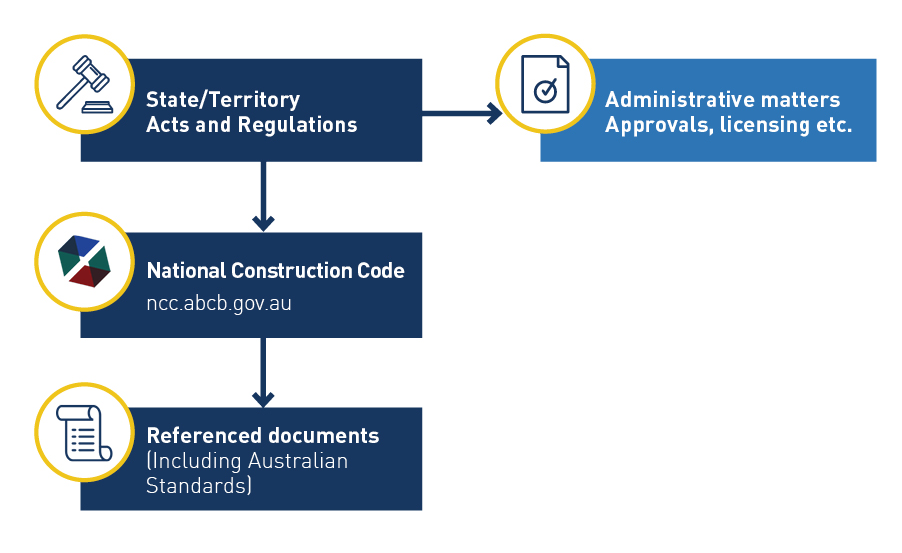Legislation
Introduction
What is the National Construction Code (NCC)?
The NCC provides the minimum necessary requirements for safety, health, amenity and sustainability in the design and construction of new buildings (and new building work in existing buildings) throughout Australia. It is a uniform set of technical provisions for building work and plumbing and drainage installations throughout Australia whilst allowing for variations in climate and geological or geographic conditions.
The NCC is an initiative of the Council of Australian Governments (COAG) developed to incorporate all on-site construction requirements into a single code. The NCC is comprised of the Building Code of Australia (BCA), Volume One and Two; and the Plumbing Code of Australia (PCA), Volume Three.
- NCC Volume One primarily applies to Class 2 to 9 (multi-residential, commercial, industrial and public) buildings and structures.
- NCC Volume Two primarily applies to Class 1 (residential) and 10 (non-habitable).
- NCC Volume Three applies to plumbing and drainage for all classes of buildings.
How it Works?
The National Construction Code (NCC) is a performance-based code containing all Performance Requirements for the construction of buildings. It is built around a hierarchy of guidance and code compliance levels, with the Performance Requirements being the minimum level that buildings, building elements, and plumbing and drainage systems must meet. A building, plumbing or drainage solution will comply with the NCC if it satisfies the Performance Requirements, which are the mandatory requirements of the NCC.
The Performance Requirements are also supported by General Requirements, which cover other aspects of applying the NCC including its interpretation, reference documents, the acceptance of design and construction (including related evidence of suitability/documentation) and the classification of buildings within the NCC.
The key to the performance-based NCC is that there is no obligation to adopt any particular material, component, design factor or construction method. This provides for a choice of compliance pathways. The Performance Requirements can be met using either a Performance Solution (Alternative Solution) or using a Deemed-to-Satisfy (DTS) Solution.
Performance Solution
A Performance Solution is unique for each individual situation. These solutions are often flexible in achieving the outcomes and encouraging innovative design and technology use. A Performance Solution directly addresses the Performance Requirements by using one or more of the Assessment Methods available in the NCC.
Deemed-to-Satisfy Solution
A DTS Solution follows a set recipe of what, when and how to do something. It uses the DTS Solutions from the NCC, which include materials, components, design factors, and construction methods that, if used, are deemed to meet the Performance Requirements.
Code Compliance
The NCC Performance Hierarchy shows that a Building or Plumbing and Drainage Solution can achieve compliance with the Performance Requirements by using an Performance Solution (Alternative Solution) or a Deemed-to-Satisfy (DTS) Solution.
Assessment Methods, which are located within the General Requirements of the NCC are used to determine whether a solution complies with the relevant NCC Performance Requirements.
Assessment Methods
The NCC contains four Assessment Methods. Any combination of them can be used to determine that a Building or Plumbing and Drainage Solution complies with the Performance Requirements.
- Evidence of Suitability requires evidence, as described in A2.2, to support claims that a material, form of construction or design meets the Performance Requirements or DTS Provisions.
- Verification Methods are tests, inspections, calculations or other methods, which determine whether a proposed Building or Plumbing and Drainage Solution complies with the relevant Performance Requirements. Verification Methods are not limited to using those in the NCC. Another Verification Method may be used if the appropriate authority is satisfied that it establishes compliance with the NCC. However, in making a decision, the appropriate authority may have regard to the relevant Verification Methods or DTS Provisions provided within the NCC.
- Comparison with the DTS Provisions allows a comparison between the DTS Provision and a proposed Building or Plumbing and Drainage Solution. If it can be demonstrated to the appropriate authority that the Solution complies in an equivalent or superior way to the DTS Provisions, then it can be deemed to meet the relevant Performance Requirements.
- Expert Judgement is the judgement of a person who has the qualifications and experience necessary to determine whether a Building or Plumbing and Drainage Solution complies with the Performance Requirements. Where physical criteria are unable to be tested or modelled by calculation, the opinion of a technical expert may be accepted.
Compliance with the NCC
The infographic outlines the three options to compliance when using the NCC: a Performance Solution, a Deemed-to-Satisfy Solution or a combination of both. It also links the relevant Assessment Methods to each of these compliance solutions.
Figure 4: Infographic on Performance Requirements (Source: https://www.abcb.gov.au/Resources/Publications/Education-Training/Compliance-with-the-NCC)
Regulatory Framework
National Construction Code (NCC)
The NCC is given legal effect by relevant legislation in each State and Territory. This legislation prescribes or "calls up" the NCC to fulfil any technical requirements that are required to be satisfied when undertaking building work or plumbing and drainage installations.
Each State and Territory's legislation consists of an Act of Parliament and subordinate legislation which empowers the regulation of certain aspects of building work or plumbing and drainage installations, and contains the administrative provisions necessary to give effect to the legislation.
Administrative Provisions
Administration provisions typically covered in the enabling or subordinate legislation include:
- Plan submission and approval procedures
- Issue of permits
- Inspections and audits
- Provision of evidentiary certificates
- Issue of certificates
- Review and enforcement of standards
- Fees and charges












